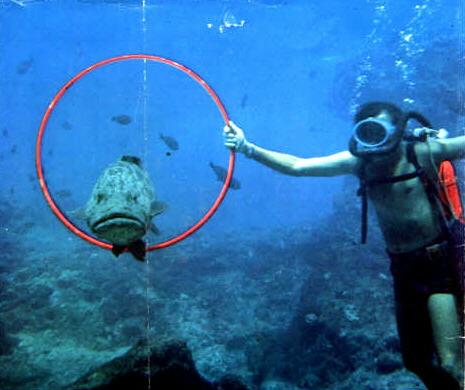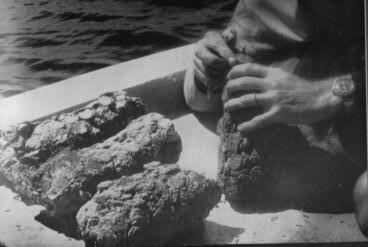Sir Arthur Clarke describes the thrill of the discovery as a
postscript given below to his junior book Indian Ocean
Adventure published in 1961. The story expands in his junior
title Indian Ocean Treasure published in 1964 in the same year
as the main book The Treasure of the Great Reef where he
describes the Mogul Silver. All three
books are illustrated with photographs by Mike Wilson. The appended
biography is also from 1961.
Postscript
Since I wrote those last words, and while this book was being
prepared for publication, something absolutely incredible has
happened--something so much like fiction that I won't blame you you
think I am making up. We have been back to the Reef--
and we have found treasure.
I can give only the bare facts here, for what may be our greatest
underwater adventure is just beginning, and will be many months before
we know how will end.
On March 12, 1961, Mike Wilson left for a ten-day visit to the Great
Basses Reef with two young American boys, Mark Smith, aged thirteen,
and Bobby Kriegel, aged fourteen, to make the film I mentioned a few
paragraphs ago. Mark and Bobby are both excellent swimmers, and Mark
was to star in the film. Rodney, unfortunately, was away on an
expedition in the Maldive Islands, four hundred miles west of
Ceylon, so he could not go on this trip.
|
The filming went well, though as yet we have not the results. Sinbad,
Ali Baba, and Aladdin were very co-operative--so much so that was
sometimes impossible to stop them performing in front of the
cameras. Once a slightly overeager Sinbad swallowed young Mark's arm
up to the elbow, and Mark is very proud of his scars. But all this is
now another story
For one day, when the water was not clear enough for filming, Mike,
Mark, and Bobby decided to go for a long swim and explore a new region
of the Reef. In all our visits, we have never had time for
sightseeing--we have always been so busy on one job or another. This
morning no work could be done, and that is one of the luckiest things
that has ever happened to us.
| 
Ali Baba goes through the hoop again.
|
Mike, Mark, and Bobby swam a long, long way from the lighthouse ( how
far, I will not say ). They were thinking of turning back when Mike
spotted something on the sea bed that he had been looking for, in
vain, for many years. It was an old cannon--a very tiny one, only about
two feet long--shining brightly in the sunlight as had been lost only
yesterday.
Mike dived down and discovered that the little cannon was made of
bronze. Near was another of the same size, though in a much more
corroded state. At first sight there was no sign of anything else, but
there could be no doubt that this marked the site of a wreck. When an
old ship or galleon breaks up, its almost indestructible cannon remain
intact for centuries, silent reminders of an ancient tragedy.
At once, with the eager assistance of the boys, Mike started to search
systematically for signs of other wreckage. Ninety-nine divers out
of a hundred would have passed by what he discovered--a few lumps on
the sea bed, covered with marine growths. When he scraped away the
weeds, he knew that this was the moment of which all divers dream, but
which very, very few have ever experienced.
|
Those misshapen lumps were hundreds upon hundreds of coins, cemented
together into a solid mass. With great difficulty, Mike and the boys
managed to chip one of the lumps--about the size of a coconut--away from
the place where must have rested for well over two centuries. It was
extremely heavy, and they could not have lifted it--still less brought
back to the lighthouse--if they had not had a very large inner tube
with them as a float. Using this tube, they were later able to bring
back both the cannon; these, besides being wonderful souvenirs, will
help us to date the wreck. I might also add that now these
signposts are removed, no one else will be able to locate the site.
The coins
are pure silver and were minted in India during the year 1702.
There are some five thousand in the lumps that Mike has brought back,
and many are still cemented together in the shape of their original
bags. Altogether, with the help of Mark and Bobby, he retrieved over
a hundred pounds of bullion from the Reef. With great restraint, he
did not let this unexpected find interfere with the movie-making and
was back on the set as soon as conditions allowed. The wreck could
wait, but the film could not.
Now, as I write these words a week after Mike's return to the
mainland, we are surrounded by unanswered questions and are
researching through libraries of old books and records in a hunt for
clues. What ship was this, when did she sink--and how? There was a
shot in one of the cannon; does this mean that she was engaged in
battle when she met her end? In any event, there could have been no
survivors on these cruel rocks ten miles from land.
|

The first four coin masses aboard Ran Muthu

Bobby Kriegel and Mark Smith with their finds on the
Great Basses lighthouse, photographed on the day of the discovery of the wreck
(March 22, 1961).

Coins after cleaning;
note (right) Muslim date 1113 (=1702 CE ).

All the 1961 finds by
Mike Wilson and his young companions, Mark Smith and Bobby Kriegel.
The coin mass at upper right is now in the Smithsonian Institution in Washington.
|
We ourselves cannot return to the Reef for at least half a year, for
the monsoon gales will soon be raging against the lighthouse, and no
boats will be able to go near four months to come. The rest of the
treasure is safe.
And that, of course, is the biggest question of all. It seems strange
that Mike should have hit upon these coins if they were all that the
wreck was carrying, but is possible that he just happened to spot the
captain's chest. On the other hand, may have been a bullion ship: that
is what we want to find out. Next year we will be back with a boat,
underwater metal detectors, and the proper equipment for a thorough
search. We may discover a fortune, but it is just as likely that our
expedition will cost us more than it brings back. Yet, whatever
happens, it should be an interesting trip, and we promise that you
will have a chance of reading about in due course.
About Mike Wilson and Arthur C. Clarke
Mike Wilson
was born in London, England, and is now a resident of Ceylon. He
traveled extensively in the Par East as a British merchant seaman and
later joined the army. After volunteering for parachute duty, he was
transferred to a parachute regiment and was later assigned to the
Royal Marine Commando Special Boats Section (Frogmen), where he was
trained in sabotage and raiding activities. While in the service, he
made over fifty parachute jumps, including one directly into the water
in full frogman equipment. He became addicted to underwater
exploration as a result of his frogman experiences with the Commandos,
and after his discharge, he went to Australia and became a licensed
pearl diver and studied the pearling industry. He has traveled all
over Australia, particularly in the Great Barrier Reef area, to
which he introduced the Aqua-Lung.
Arthur C. Clarke was born in Minehead, Somerset, England, and
evidenced an intense interest in science in his early boyhood. For a
while he avidly collected fossils; then his interest turned to
astronomy, and he built a small telescope from a cardboard tube and a
couple of lenses and "Spent many of my nights mapping the moon, until
I knew my way around a good deal better than around my native
Somerset." Throughout his teens, he Spent much of his time building
scientific gadgets, the most ambitious of which was a photo phone
transmitter made from a bicycle lamp that could send speech for
several yards along a modulated beam of light. At fifteen he started
writing for his school magazine and soon became the assistant editor.
When World War II broke out, Mr. Clarke left a civil service job to
join the Royal Air Force and worked with American scientists on the
first ground-controlled approach (blind landing) system, later
assuming command of the operation for the R.A.F. At the end of the
war, he entered Kings College in London and took a degree in physics
and mathematics with first-class honors. He then became assistant
editor of a scientific journal but resigned a year later to devote all
his time to his writing. In addition to the books he has done with
Mr. Wilson, he is the author of numerous scientific and
science-fiction works and has had more than a hundred stories and
articles published in such magazines as Holiday, the
Reader's Digest, the New York Times Magazine Section, the
Saturday Review, and various scientific journals. He is a Fellow of
the Royal Astronomical Society and was chairman of the British
Inter-planetary Society for five years.
Some years ago Mr. Clarke began to investigate another little known
frontier--the world beneath the seas. With his friend and colleague
Mike Wilson he spent months roaming the Great Barrier Reef off the
coast of Australia and told about their exciting adventures in THE
COAST OF CORAL, which is illustrated with beautiful color
photographs by Mr. Wilson. In 1955 the two embarked on another long
odyssey to explore and photograph the waters off the coast of Ceylon,
the island known as "The Pearl of the Orient." This expedition is
reported on in THE REEFS OF TAPROBANE, also illustrated with
photographs by Mike Wilson.
The writer and photographer became so fascinated with Ceylon and the
waters around that they returned there to continue their
explorations. They now live there permanently, exploring the waters
and recording their adventures in books and motion pictures.
Photographs copyright © 1961 by Mike Wilson
Text copyright © 1961 by Arthur Charles Clarke




